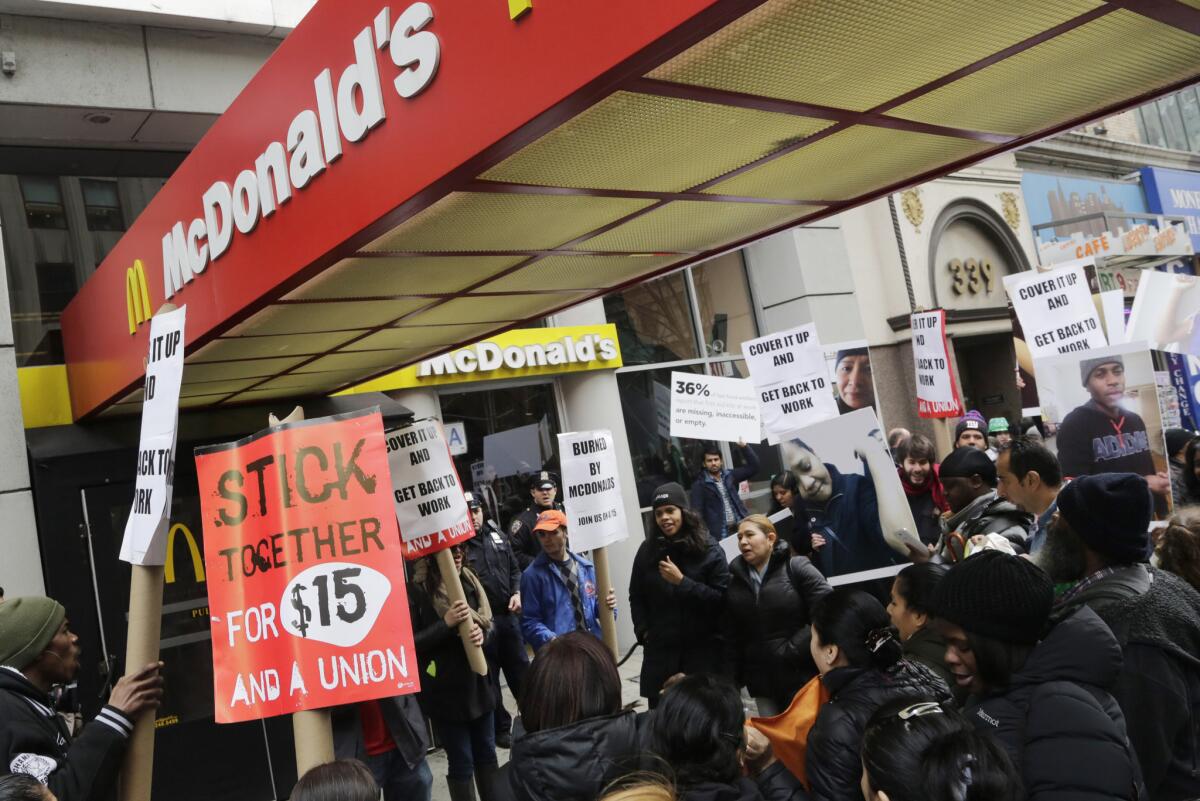McDonald’s is giving 90,000 workers raises and vacation time

McDonald’s Corp. will raise the minimum wage for 90,000 U.S. workers by more than 10% this summer, becoming the first major fast-food corporation to bow to pressure to improve circumstances for low-paid workers nationwide.
The increase, which follows similar moves recently by retailers including Wal-Mart Stores Inc. and Target Corp., could compel McDonald’s quick-service rivals to follow suit, according to analysts and economists.
The Oak Brook, Ill., business said it would start paying employees at its company-owned restaurants at least $1 an hour more than the local minimum wage on July 1. The plan also includes extra benefits for workers. The changes apply only to the 10% of approximately 14,000 McDonald’s restaurants that aren’t owned by franchisees.
Executive turnover and more than a year of declining sales show that “McDonald’s has been having a tough time of it,” said Alan Berube, a senior fellow at the Brookings Institution. “Their bottom line hasn’t been quite so great, so maybe they haven’t had the luxury of increasing their wages, but now they’re recognizing that maybe they don’t have a choice.”
The strategy shift at McDonald’s, which has long had a reputation for paying employees so little that many hover barely above the poverty line, is part of a sweeping change in corporate attitudes toward worker welfare as companies find themselves competing for talent.
Five years into the recovery, the national economy is shaking off the last vestiges of the recession. Hiring is starting to take off and the job market has tightened, with unemployment at 5.5% in February. With more options at their disposal, workers are less desperate for jobs.
“Large companies don’t want to destroy their reputation for customer service, which means they need to pay employees something more than rock-bottom wages if they want them to be engaged and committed,” said Chris Tilly, director of UCLA’s Institute for Research on Labor and Employment. “If you go to McDonald’s and wait 20 minutes for your burger and then the wrong thing gets delivered, you’re not going to go back.”
But a huge swath of Americans continue to toil at the bottom of the wage ladder. Nearly 2 out of 3 workers earning the federal minimum wage ($7.25 an hour) or less in 2013 were employed in service occupations, mostly those related to food preparation and serving, according to Bureau of Labor Statistics data.
In cities such as Los Angeles, the cost of living is rising, leaving low-paid employees struggling to pay their bills. An ongoing series of protests — including events planned worldwide for April 15 — have urged employers to boost pay.
“Retail and food service are quite visible in the prevalence of their low-wage work,” Berube said. “The public identifies with those workers because they interact with them all the time in the way they don’t with people in a clothing factory.”
Barring restaurant managers and more senior workers, McDonald’s said that it would adjust wages based on workers’ tenure and performance at its restaurants. The company projected that by the end of 2016, average wages at non-franchise restaurants would be higher than $10 an hour.
The company also said that employees of those stores with at least a year of McDonald’s experience will start this summer to accrue personal paid time off — on average 20 hours a year for someone working 20 hours a week. Workers will be paid for any personal time not taken.
But McDonald’s policy won’t apply to restaurants that aren’t company owned. The more than 3,100 franchisees who operate 90% of those McDonald’s stores in the U.S. will make decisions about pay and benefits at their own discretion.
Christine Owens, executive director of the National Employment Law Project, said many of those franchise workers are adults trying to support families on inadequate hours. Even the employees eligible for the new wage rule will remain trapped near the poverty line, she said.
Edgar Gonzalez, 22, said he earns $9 an hour as a full-time maintenance worker at a Leimert Park McDonald’s. In his two years there, he said, he has done “the job of three people” and has constantly asked for a raise to help support his daughter and his girlfriend.
But because the restaurant is owned by a franchisee, he won’t benefit from the new wage policy.
“To give wage increases for workers at just 10% of the stores is a joke, and I’m a little mad and upset about it,” he said. “It’s like I don’t matter to the company.”
McDonald’s also said it would offer tuition assistance and other help to the 750,000 employees at company- and franchisee-owned restaurants who are finishing high school, paying for college or studying English as a second language.
“We are acting with a renewed sense of energy and purpose to turn our business around,” said Chief Executive Steve Easterbrook. “We know that a motivated workforce leads to better customer service, so we believe this initial step not only benefits our employees, it will improve the McDonald’s restaurant experience.”
In early March, Easterbrook replaced Don Thompson, who gave up the chief executive role after two years at the helm.
During his tenure, McDonald’s suffered five straight quarters of declining same-store sales at U.S. restaurants. The company lost market share to competitors such as Burger King as well as fast-casual rivals such as Five Guys Burgers and Fries, which serve higher-quality fare at moderate prices.
On Wednesday, the Standard & Poor’s credit rating firm lowered its McDonald’s outlook to “negative” from “stable,” citing doubts that the company can elevate its revenue, market share and foot traffic within two years.
In January, McDonald’s said while announcing its fourth-quarter earnings that it would implement its smallest capital budget in five years. The company is also testing an all-day breakfast menu and plans to allow customers to customize more of their orders.
“There are changes in the way people are dining out, and there is also a lot more competition” from chains such as Chipotle and Panera Bread, said Robert Schulz, managing director at Standard & Poor’s Ratings Services. “We see this as part of the turnaround.”
Other fast-food companies may soon lift wages to copy McDonald’s, analysts said. The industry is known for intense competition, with major rivals adopting trends such as cage-free eggs and breakfast sandwiches in quick succession.
“We are kind of at the horizon of larger changes to come,” IBISWorld analyst Andrew Alvarez said. “A lot of the more conventional players who have enjoyed a long and steady position at the top are now trying to shake things up.”
Similar plans are already in motion at several major retailers. Wal-Mart plans to raise its entry wage to at least $9 an hour this month and then to $10 by next February. Target and T.J. Maxx are also on board.
Gap Inc. was among the first movers, saying last year that it would set its minimum hourly wage at $9 and then raise the floor to $10 this year. Company executives have said that job applications surged almost immediately after the announcement.
Economists said that advocates for minimum wage increases, who have in recent years shifted pressure from national and state governments to county and city legislators, may increasingly set their sights on individual companies.
“Activists are working at all levels,” said Berube of Brookings. “They’ll take progress wherever they can find it.”
tiffany.hsu@latimes.com
shan.li@latimes.com
Times staff writer Christine Mai-Duc contributed to this report.








